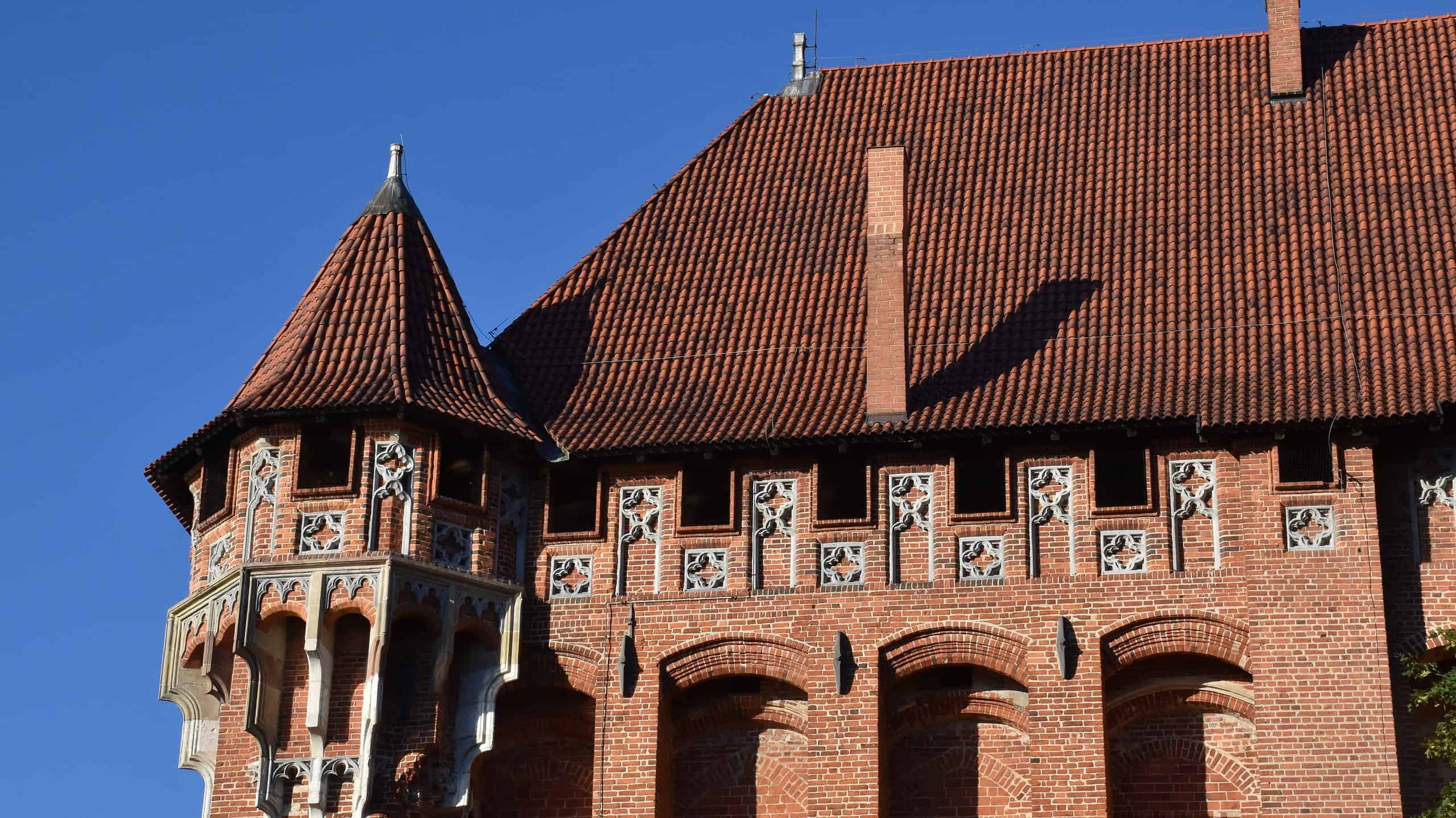Malbork Castle, in the town of Malbork, Poland, is a beautiful testament to the grandeur and power of the Teutonic Knights of the medieval period. Construction of the castle commenced in 1280 and was completed in 1406. Malbork is one of the largest brick castles in the world and a UNESCO World Heritage site. The castle is the largest in the world when measured by land area /grounds, spanning 52 acres.
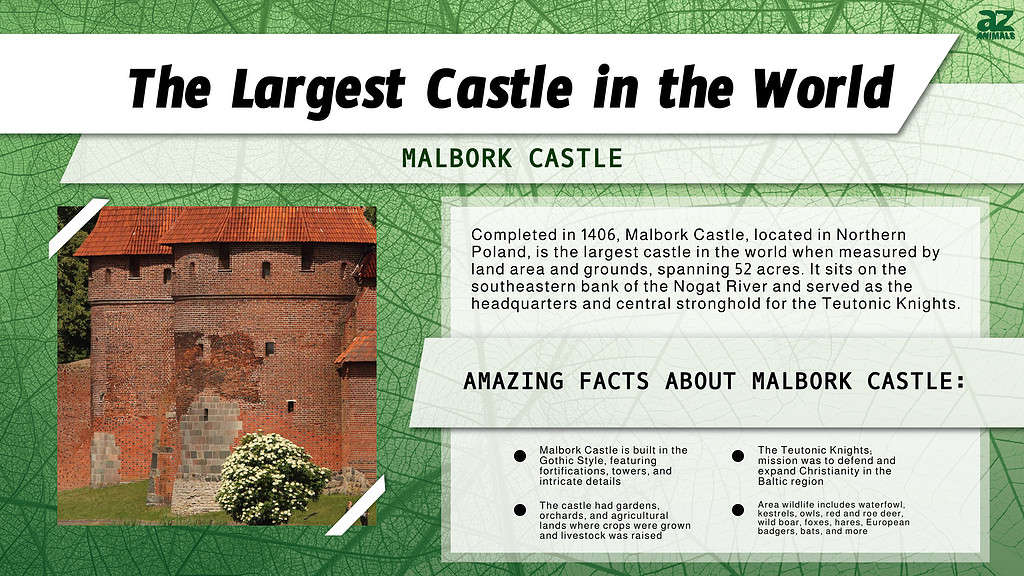
Malbork Castle holds an important place in European history. Its awe-inspiring fortifications, intricate Gothic design, and rich historical significance make it a treasure trove for enthusiasts of medieval architecture and the accompanying tales of chivalry, conquest, and religious fervor. So put on your chain mail and grab your helmet as we discover the wonder that is Malbork Castle.
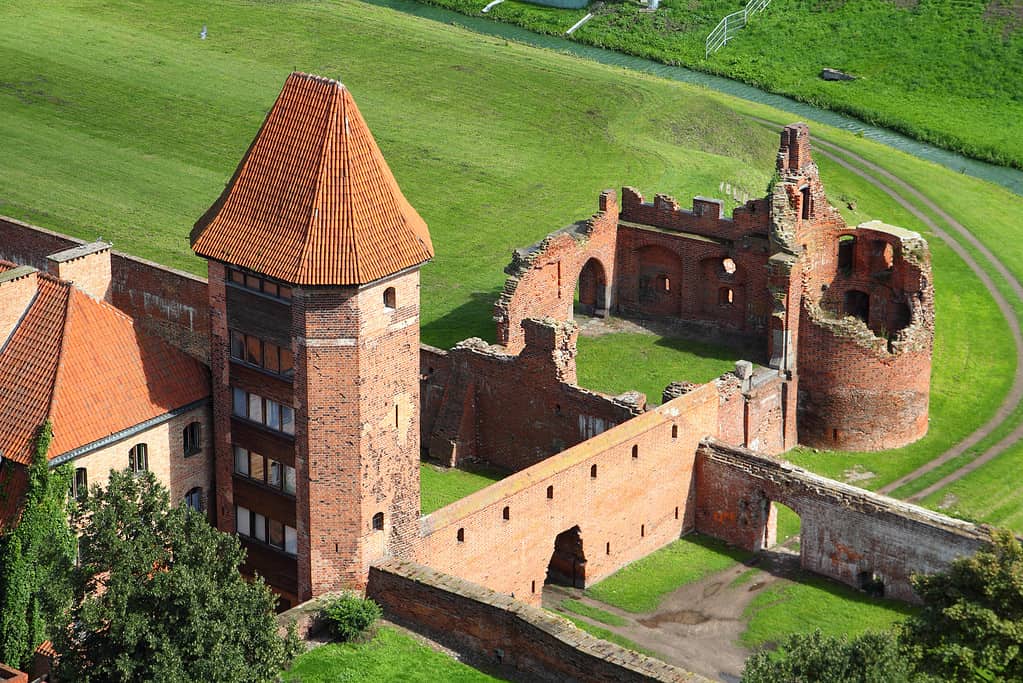
Completed in 1406, Malbork is one of the largest brick castles in the world.
©Tupungato/Shutterstock.com
The Largest Castle in the World: Location
Malbork Castle is located in the town of Malbork in Northern Poland. The castle is positioned on the Southeastern bank of the Nogat River, a tributary of the Vistula River. The Nogat River flows adjacent to the castle, adding to its strategic significance during the medieval period as it provided a natural defense and facilitated trade routes. The castle’s location near the river allowed the Teutonic Knights to control and monitor water traffic, reinforcing their authority in the region.
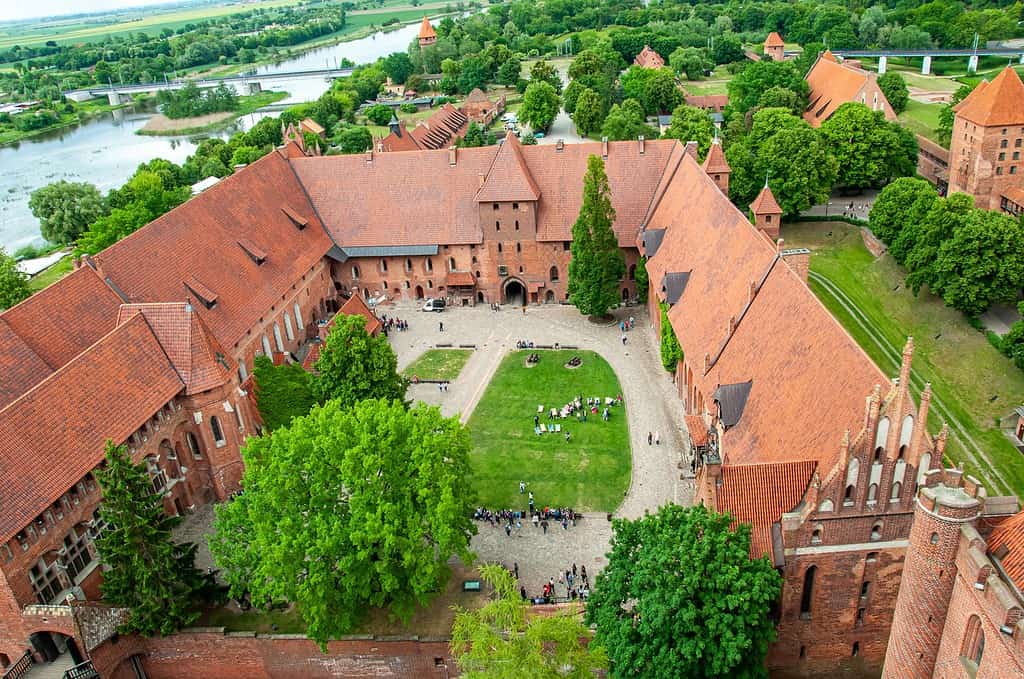
Malbork Castle is positioned on the Southeastern bank of the Nogat River, a tributary of the Vistula River.
©Kovalov Anatolii/Shutterstock.com
The Largest Castle in the World: The Teutonic Order
A Teutonic Knight refers to a member of the Teutonic Order, also known as the Order of Brothers of the German House of Saint Mary in Jerusalem. The Teutonic Order was a medieval military-religious order founded in the late 12th century. Originally established as a hospital order to provide medical care for Christian pilgrims in the Holy Land, the Teutonic Order soon transformed into a powerful military force.
The primary mission of the Teutonic Knights was to defend and expand Christianity in the Baltic region.
The knights played a significant role in the Northern Crusades. These were a series of military campaigns the goal of which was to conquer and Christianize pagan territories. The Baltic region consists of present-day Poland, Lithuania, Latvia, and Estonia. The knights were known for their distinctive white surcoats adorned with a black cross, their iconic symbol. The Teutonic Knights operated from various castles and commanderies throughout their territories. Malbork Castle served as their headquarters and central stronghold. The knights exercised political, economic, and military control over vast lands.
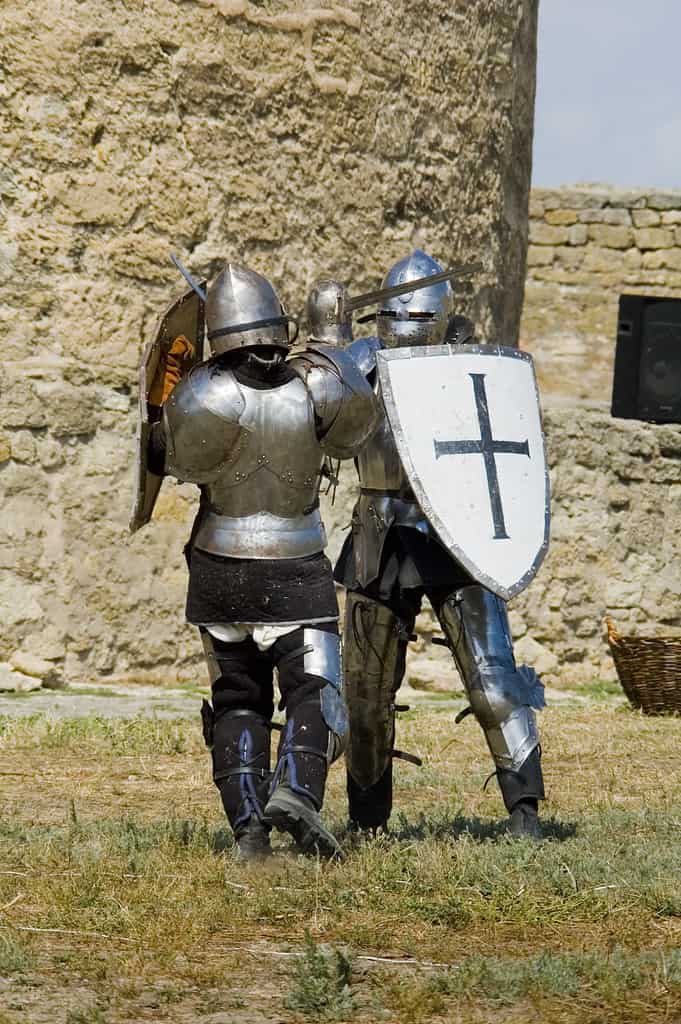
The knights were known for their distinctive white surcoats adorned with a black cross, their iconic symbol.
©dtopal/Shutterstock.com
Chivalry and Charity
In addition to their military endeavors, the Teutonic Knights were deeply committed to their religious calling. They followed a strict code of conduct based on the ideals of chivalry, emphasizing virtues such as loyalty, honor, and the protection of the weak. The order also engaged in charitable activities, including providing medical care and establishing hospitals.
Over time, the power of the Teutonic Order diminished, and its influence waned. The order faced challenges from neighboring powers and internal conflicts. Eventually, the order transformed into a purely religious affair. The Teutonic Knights and their legacy left a lasting impact on the history, culture, and architecture of the regions they once ruled. Malbork Castle stands as an enduring symbol of their military might and religious dedication.
The Largest Castle in the World: Architecture
The castle’s architectural style is predominantly Gothic, characterized by its impressive fortifications, towers, and intricate details. The entire complex consists of three main sections: the High Castle, Middle Castle, and Outer Bailey. The High Castle, which housed the Grand Master and high-ranking officials, is the most significant part and features the Grand Master’s Palace, the Great Refectory, and the Grand Refectory Church. The Middle Castle was primarily used for administrative purposes, while the Outer Bailey contained workshops, stables, and living quarters for the lower-ranking members of the Order.
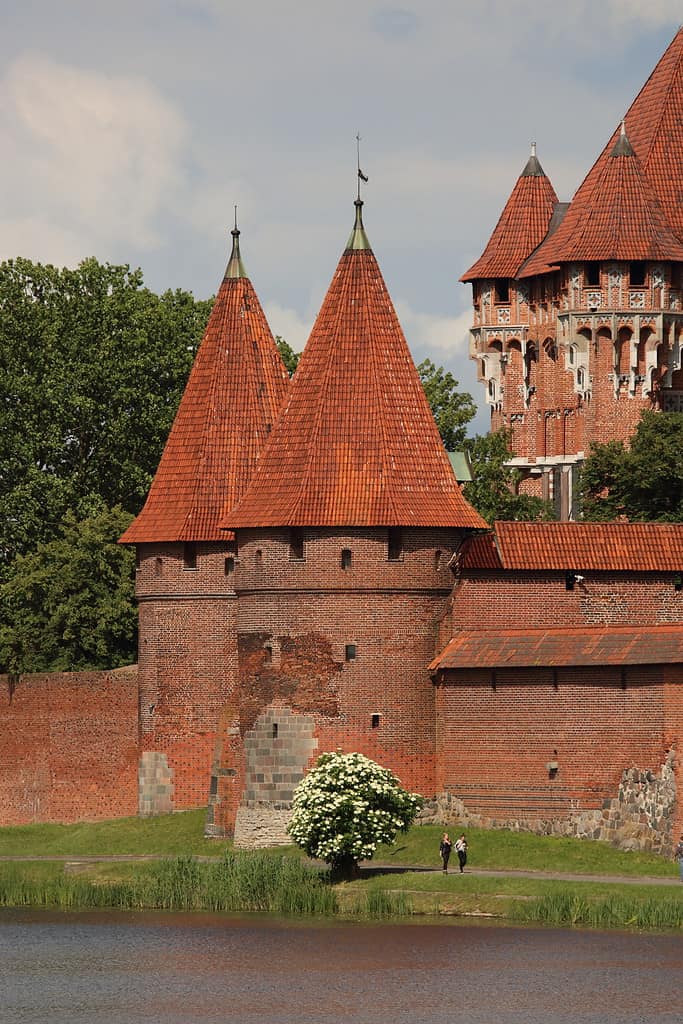
The castle’s architectural style is predominantly Gothic, characterized by its impressive fortifications, towers, and intricate details.
©Wiola Wiaderek/Shutterstock.com
Malbork Castle is renowned for its imposing defensive structures. The fortifications include massive walls, towers, and moats, which reflect the castle’s military significance during the medieval era. The most famous towers within the castle complex are the High Tower, Mill Tower, and Prison Tower. Visitors can explore various chambers and halls. A highlight is the Great Refectory, where the knights would gather for communal meals. The Grand Master’s Palace, features opulent living quarters, a chapel, and a council chamber.
Restoration
Through the centuries, the castle faced numerous challenges, including fires, wars, and neglect. However, extensive restoration efforts were undertaken in the 19th and 20th centuries to preserve its historical and architectural value. The restoration worked to reconstruct the castle to its original grandeur, using historical records and archaeological findings for reference. Today, the castle stands as a testament to the dedication and expertise of those involved in its restoration.
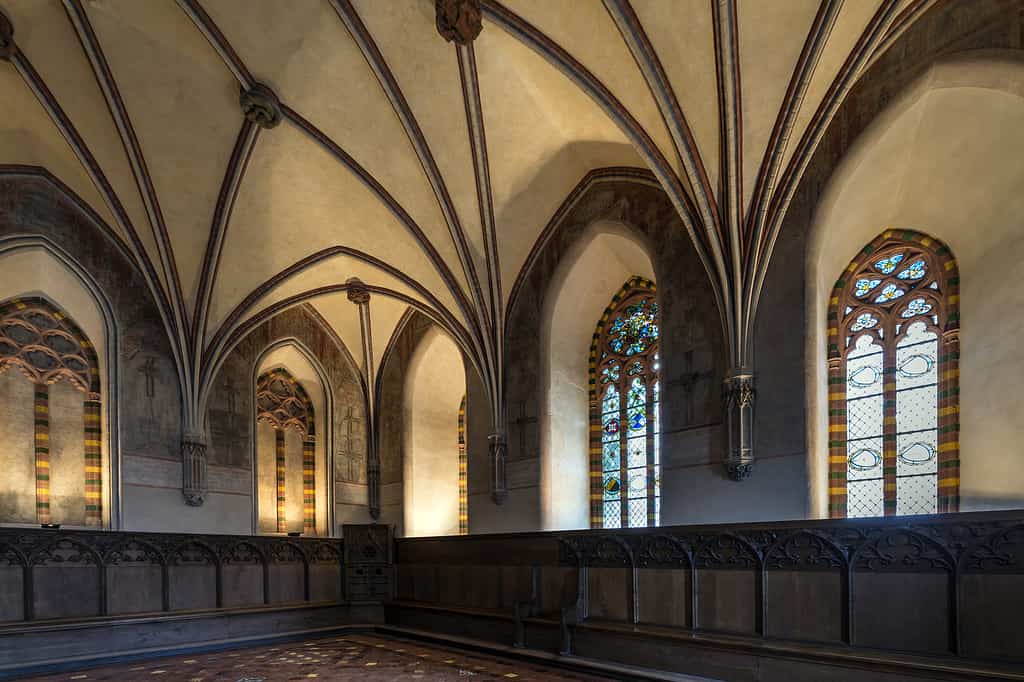
The restoration worked to reconstruct the Malbork Castle to its original grandeur, using historical records and archaeological findings for reference.
©Cinematographer/Shutterstock.com
The Largest Castle in the World: Self-sustaining
To a great extent, Malbork Castle was designed to be self-sufficient. The castle complex was not just a military fortress. It was also a self-contained community that sustained the Teutonic Knights and their activities. It had various facilities and features that enabled it to function independently. The castle had its own agricultural lands and pastures where crops were grown and livestock, such as cattle and sheep, were raised. These resources provided the castle inhabitants with food, including meat, dairy products, and grains.
Within the castle complex, there were gardens and orchards where fruits, vegetables, and herbs were cultivated. These gardens supplied fresh produce and medicinal herbs for the inhabitants.
Being near the Nogat River, Malbork Castle had access to a fishery, which provided a source of fish for the castle’s residents. The castle had its own water supply system, including wells, cisterns, and water storage facilities, to meet the daily water needs of the community.

Within the Malbork Castle complex, there were gardens and orchards where fruits, vegetables, and herbs were cultivated.
©Dimitris Panas/Shutterstock.com
Malbork Castle housed various workshops where skilled craftsmen, such as blacksmiths, carpenters, and potters, produced necessary items and carried out repairs. These workshops enabled the castle to maintain its infrastructure and fulfill the needs of the community. Malbork Castle had storage facilities, including granaries, cellars, and warehouses, to store provisions, grains, wine, and other supplies. This allowed the castle to stockpile resources for times of need, such as during sieges or winter months when external supplies might be limited. Luxury items or goods that were not locally produced may have been acquired through trade or tribute from the surrounding territories controlled by the Teutonic Knights.
Castle Wildlife
The area around Malbork Castle in Northern Poland is home to a wide array of wildlife. The region is a haven for various bird species, including waterfowl (Anseriformes) such as ducks, geese, and swans. Kestrels and owls can also be spotted in the surrounding forests. The forests and meadows surrounding Malbork Castle are home to a range of mammals. These include red deer (Cervus elaphus), roe deer (Capreolus capreolus), wild boar (Sus scrofa), foxes (Caninae), hares (Lepus), and European badgers (Meles meles). Squirrels (Sciuridae) and bats (Chioptera) are also prevalent in the area. Given the proximity of the Nogat River and its tributaries, the waters around Malbork support a variety of fish species. Wetland areas near the castle provide a habitat for amphibians and reptiles, such as frogs (Anura), toads (Bufonidae), newts (Pleurodelinae), and various snake species (Serpentes).
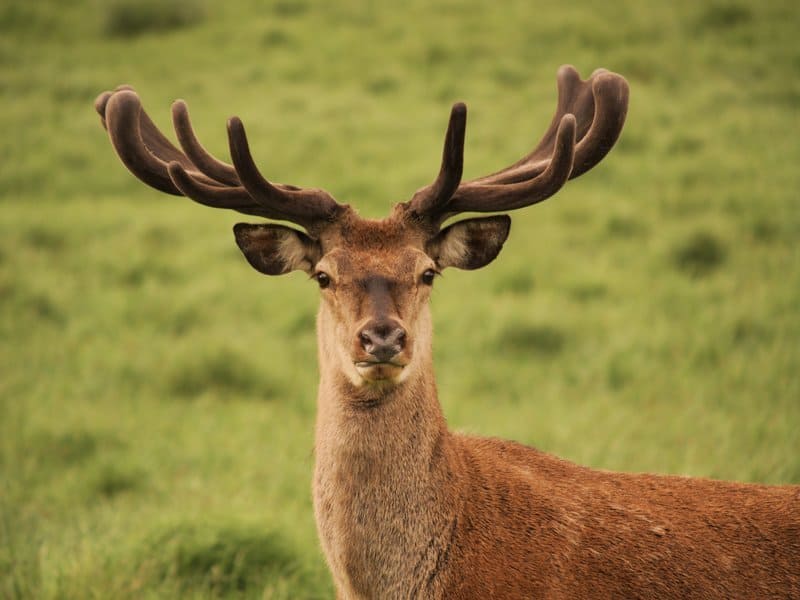
Red deer (
Cervus elaphus) may be seen around Malbork Castle.
©Karl Moor / Creative Commons – Original
The Largest Castle in the World: Tourism
Malbork Castle attracts tourists from around the world who come to marvel at its grandeur and learn about its rich history. The castle offers tours and exhibitions that provide insights into the life of the Teutonic Knights, medieval warfare, and the castle’s restoration process. Visitors can explore the various sections of the castle, admire the architectural details, and appreciate the vast collection of medieval artifacts and artworks on display.
Thank you for reading! Have some feedback for us? Contact the AZ Animals editorial team.

